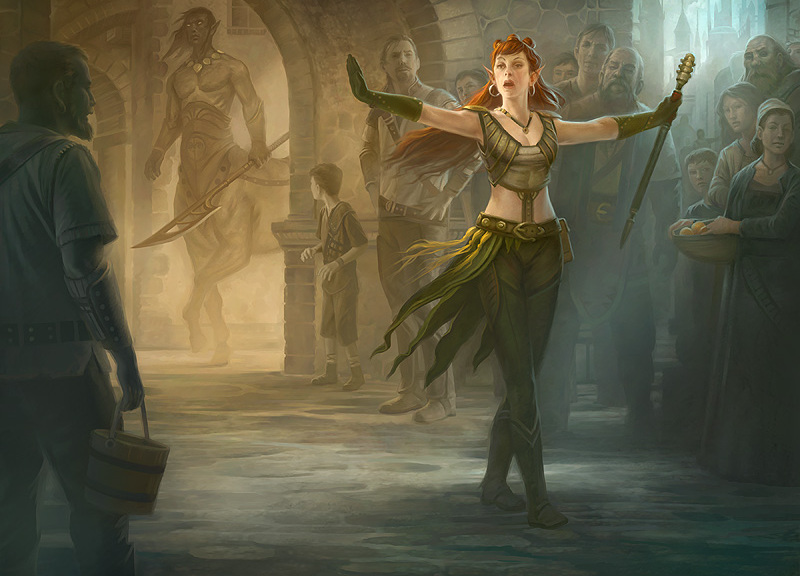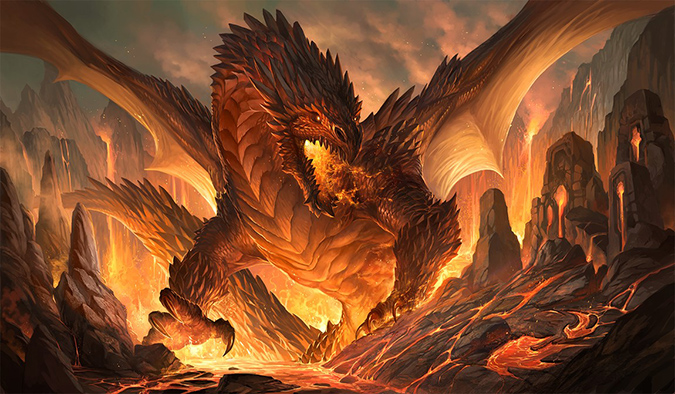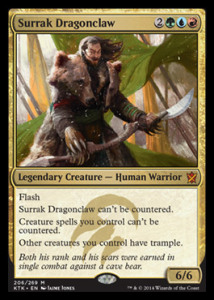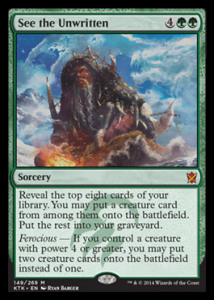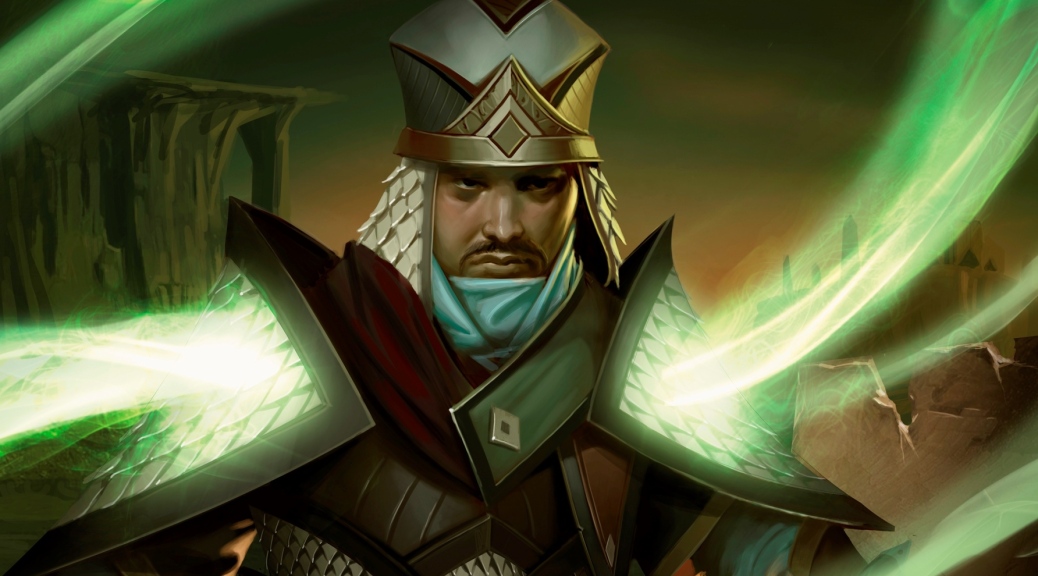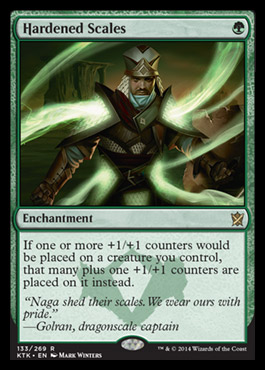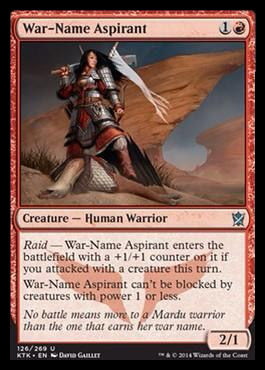By: Jared Yost
With rotation upon us, everyone is expecting the newest tech from Khans to totally alter the Standard landscape. With all the wedge combinations, in addition to the various two color decks that should also see play, there will be plenty of opportunity for brewing and creating amazing new decks.
I see rotation in a different light. In order to get the best deals on Magic cards that I can, I’ve come to understand that the block rotation is the best time of year to get in on cards that were previously twice as expensive or more. However, you shouldn’t be too hasty. The best time to start looking for these deals is about two to three months after the latest set has been released in order for the prices from the old rotating sets to really dive. At this point, a good amount of Standard only players will have liquidated most of their holdings. Eventually the rest will follow and the market will have a large amount of staples from the previous Standard set that are now only eternal legal.
In the past, I’ve done these set reviews for Innistrad block when it rotated from Standard. See here and here. I will identify cards I’m looking at and then indicate which formats of Magic I believe their future price will be driven by. The structure will be as follows:
Sets
- Return to Ravnica
- Gatecrash
- Dragon’s Maze
- M14
Order of Rarity for Sets
- Mythic
- Rare
- Uncommon (if applicable)
- Common (if applicable)
Foil vs Nonfoil – Mentioned per card if applicable. I will only mention foil if the card has ubiquitous Commander or Eternal appeal.
Today I will start with Return to Ravnica and Gatecrash, then next week I will cover Dragon’s Maze and M14.
Return to Ravnica
MYTHIC
FORMAT – Modern, Commander
Sphinx’s Revelation is currently the most expensive mythic from Return to Ravnica averaging $8 retail and a TCG Low of about $6.50. While the card is pretty decent in Commander I think the future of Sphinx’s Rev lies in its use for Modern. It is usually played as one or two copies in the current meta’s UWx lists that are either control or combo control based.
Does this eternal demand mean that Sphinx’s Rev will always be around $8 moving forward? I think not. There is still room to drop since the main demand for the card comes from Standard. Outside of UWx lists Sphinx’s Rev does not see any other eternal demand. While I don’t think we’ll see this mythic dropping to $3 or less I do believe there is plenty of room to drop and I think it will land somewhere between $4 and $6. Definitely pick up a few if you play Modern or for an EDH deck though don’t go too deep on this one. The demand isn’t quite there yet and this card is generic enough that it could see a reprint in a supplemental product.
FORMAT – Commander, Casual
Believe it or not, this mythic is up there among the top 5 most expensive mythics from RTR at about $3 retail and a TCGLow of $2. This demand is all is casual here. It is definitely nice in green Commander decks and casuals are driving the price towards a stable $2.50.
I think now is the time to buy in on these for future growth. Since the demand is casual driven, I could see it rising in price over time similar to Ghostly Prison or other cards that don’t really see eternal play but still are popular with the casual crowd. I don’t think the Wurm will ever go below $2.
Vraska the Unseen & Jace, Architect of Thought
FORMAT – Commander, Casual
Planeswalkers are generally good pickups as long as they aren’t Tibalt. Jace and Vraska could see eternal play yet I don’t think they’re quite powerful enough for Modern or other eternal formats. Planeswalkers always sell and trade well so if you can pick either of these up for $3 or less in trade I would do it. Even though they have a duel deck printing I still think in the future casual players will want them for collections.
FORMAT – Commander, Casual
I like foils of Trostani for future gains. They are currently only around $8 retail and I think that is a good pickup price for her. Players will want to use her as a general for Commander decks in the future so I think the foil versions hold the most potential here.
You can pick up nonfoils of Trostani for less than $1 in some places and that could be good for a year or two down the road. I wouldn’t try to pick up nonfoils though as the profit margins are slim and there is a chance for a reprint in the coming years.
FORMAT – Commander, Casual
Casuals love their angels and the foil price of this card reflects that demand. The foil multiplier for Angel of Serenity is 0.149 – that is a nonfoil is worth about 15% of the price of a foil. That gap is huge! I can only see it increasing in the coming years due to angel collectors and the demand from Commander (Kaalia players, I’m thinking of you) so picking up foils after rotation will ensure you get her at a good price.
RARE
Abrupt Decay & Deathrite Shaman
FORMAT – Legacy
The first rares on the list are Abrupt Decay and Deathrite Shaman, two of Legacy’s biggest stars since their debut. Abrupt Decay is the most expensive card from Return to Ravnica at $13 retail, and Deathrite Shaman is #5 at $9.40 retail. Deathrite has dropped from his average of $12-$15 before his Modern ban to below $10 now. I think that rotation is a great time to pick up more Deathrite copies in anticipation of future Legacy play. I could easily see him going back to $12-$15 in a year without a reprint. He will trade easily to both hardcore Legacy players and casual players, and will always be wanted on buylists.
Abrupt Decay I believe has peaked for a while. I don’t think the profit margins a year from now are worth it for non-foil copies at $13. I don’t think it could ever reach $25+ in only a year especially since it could reprinted in the upcoming Modern Masters two or another product.
Foils of both are a decent investment, even now at $90 & $75 respectively. The foil copies only stand to gain in the future since both are played quite extensively in Legacy and players in that format love to foil out there decks.
Shocklands (All 10 of Them)
FORMAT – Modern, Commander
Next of course are the Shocklands from RTR & GTC.
Advice for those who haven’t gotten their shocklands yet:
Personally I would focus on picking up the blue lands (Steam Vents, Hallowed Fountain, Watery Grave, and Breeding Pool) however you can’t go wrong diversifying and picking up whatever shocks you can get your hands on. They will be played in Modern extensively, and with the addition of the Onslaught fetchlands being added to Modern the demand for these lands will only continue to go up. I predict that decks we haven’t seen before will start to surface due to the allied fetchlands being added to the card pool and that these decks will be more focused on two color strategies since additional mana fixing options have now opened up. Due to this, even the non-blue lands could see play if a new two color archetype emerges in Modern.
Advice for those looking at these as real estate for future value:
Don’t expect extreme gains from shocklands because Wizards did their due diligence and printed an abundance of these things. At this point, I would only pick up lands that you need for decks you might play. Don’t pick up these lands expecting to make a killing off them, because these aren’t spiking up in price for quite some time. They should be pretty stable, with small gains here and there, in the foreseeable future.
Foils of shocklands are pricy but worth it. These should gain more in a shorter amount of time since Modern players will be looking to start foiling out decks eventually. Once RTR & GTC are out of print foil lands will be even harder to come by. Pick these up as you can and you won’t be disappointed in the future.
FORMAT – Commander
Both foils and nonfoils alike of Chromatic Lantern will be good targets. This artifact quickly became one of the most ubiquitous cards in Commander decks since it allows three color Commander decks to have amazing mana fixing in addition to being a mana rock for any color. Pick up as many of these as you can, especially foils, because they are sure to go up.
FORMAT – Commander
Any deck that plays blue will play Cyclonic Rift because it is so backbreaking in Commander if you are on the receiving end of one. Like Chromatic Lantern, foils will be an especially nice acquisition for the future.
FORMAT – Modern, Casual
I’ve seen some grindy Modern lists out there floating around that include Pack Rat as a way to get through all the removal that seems to exist in the format. Once RTR rotates, I think Pack Rat is going to take a huge dive. If it goes below $2 I would try to pick up some copies for Modern. You never know if it will become the feature card in a breakout deck.
Also, rats are a creature type that some casual players have a fascination with. I’m not sure why, but it couldn’t hurt to pick up some copies to satiate that demand since Pack Rat is sure to be an include in the Relentless Rats deck.
FORMAT – Modern, Legacy
One of the best graveyard hate cards printed, Rest in Peace is extremely good at shutting down graveyard based strategies. I really like foils here as Rest in Peace is played a ton in Legacy and transition well into Modern if more graveyard themed decks start popping up.
FORMAT – Commander, Casual
I really like this card as a target for casual players. It is pretty much at bulk rare status, so if you can get them as throw ins for trades I think that would be a good opportunity. This feels like the set’s Parallel Lives so I expect this card will eventually be in the $2-$3 range some time after RTR is out of print.
UNCOMMONS
FORMAT – Modern, Legacy
I think that Golgari Charm and Izzet Charm are the best charms from RTR for eternal formats. Izzet Charm is played in several Modern decks and Golgari Charm is a great sideboard card in Soltai (BUG) decks to take care of True-Name Nemesis in addition to providing other great utility. I would target foils of Golgari Charm over Izzet Charm, since Izzet Charm had an FNM promo foil which will stabilize the price of the pack foil Izzet Charm.
Gatecrash
MYTHIC
FORMAT – Modern, Casual
Domri might have potential for Modern play yet I think the majority of his value will come from casual players that like to collect planeswalkers. I think nonfoil Domri has some room to drop after rotation. If he ever goes below $7 that will be the time to pick him up. Foils at $30 are pricy but a good pickup for the long term.
He will always trade / sell well due to being a planeswalker, so you can’t go wrong picking up some Domri’s after rotation.
FORMAT – Commander, Casual
Similar to Angel of Serenity, Aurelia will be another angel that players gravitate towards for Kaalia and Aurelia Commander decks. She will always have casual appeal for Commander players. Foils will be good for future gains however I also think nonfoils have room to grow until a reprint.
Master Biomancer & Prime Speaker Zegana
FORMAT – Commander, Casual
Both Simic mythics are powerful from Gatecrash and I think both will be great pickups upon rotation.
Cards that provide lord effects (that is, add +1/+1 counters to creatures or provide a +1/+1 bump) usually do well financially as casual players gravitate towards these types of effects. Master Biomancer, while not a normal lord, provides a different yet similar effect. I think the mythic rare status will enable it to do well in the future.
Prime Speaker Zegana is an awesome commander and I think that alone will allow her to maintain value because she is so powerful in the Commander format. I would target foils here though nonfoils could also do well over time.
Gideon, Champion of Justice & Hellkite Tyrant
FORMAT – Commander, Casual
Gideon and Hellkite Tyrant are awesome for casual, Commander environments. Gideon like all planeswalkers should trade / sell well while foils of Hellkite Tyrant will gain the most in the future.
Obzedat, Ghost Council & Lazav, Dimir Mastermind
FORMAT – Commander
Pick up foils of these guys for Commander since they make great generals and are popular in in the format.
FORMAT – Legacy, Commander
Omni-Show exists in Legacy and uses Enter the Infinite to combo off. It has put up results from time to time but is currently a pet deck rather than an established archetype. Still, for under $1 I think Enter the Infinite is a good pickup. Especially since it also has Commander appeal for those of us that like to build instant win combo decks in the format.
RARE
Shocklands (All 10 of Them)
FORMAT – Modern, Commander
I’ve talked about these previously in this article, refer to the RTR shocklands for more specifics.
Boros Reckoner, Mind Grind & Consuming Aberration
FORMAT – Casual
I believe these three cards are the best casual rares from the set. All three represent cool cards that casual players salivate over. I don’t think they can lose much value and will only gain in the future.
Thespian’s Stage, Merciless Eviction, & Crypt Ghast
FORMAT – Commander
Outside of the Primordials, these three cards I believe represent the undervalued Commander rares from the set. All three are really awesome in Commander and their value will derive from that. They will all be good pickups for the future.
Primordials (all the non-banned ones)
FORMAT – Commander
Speaking of Primordials, all the Primordials (barring Sylvan due the Commander ban) will be good pickups for Commander. If they are reprinted in the latest C14 decks, the price will stabilize for a time. However, these things can get quite degenerate in Commander if left unchecked. I think even if they are reprinted they can’t get much cheaper than they are now which is around $0.30 retail. Stock up on these and a few years down the road trade them away once they reach $2 or more.
UNCOMMON
FORMAT – Modern, Casual
Clearly the best charm from Gatecrash, Boros Charm is starting to make waves in Modern on the back of burn decks that have become popular in the format over the last few months (with a burn deck even taking down GP Kobe). In addition to tournament play, Boros Charm is an amazingly popular casual card and will maintain a ton of value from that crowd. Foils and non-foils are both good targets.
FORMAT – Casual
Gift of Orzhova is a pretty bad card in all constructed environments. Even in Commander and casual formats it’s not that good. Why do I mention it? Foils are currently $5 retail for this card while normal copies are only going for bulk. There is demand for this card’s foil but not for the normal reasons.
The reason for demand is that everyone is crazy about the artwork for the card. Players aren’t getting foils for the playability, yet rather for the art which is timeless. I don’t think foils of this are going down since it clearly doesn’t see play anywhere and is still $5. Who knows, maybe we’ll start having a larger portion of the community start collecting cards for artwork. All I know is that this card’s art in particular seemed to strike a chord with Magic players and that foils are in demand. If you want one, get it upon rotation.
Summary
There are plenty of cards that should trend upwards in price after rotation from Return to Ravnica and Gatecrash once they hit their bottoms. Depending on where your collection is lacking, rotation is the perfect time to pick up any missing pieces for your collection, decks, or cubes. You can even pick up some cards in hopes of trading or buylisting them in the future once they trend upwards from their bottom. Check in again next week for my Dragon’s Maze and M14 rotation picks.
